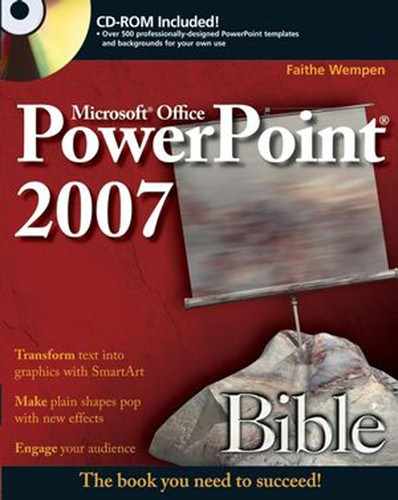Some books zoom through a software program so fast it makes your head spin. You'll come out dizzy, but basically able to cobble together some sort of result, even if it doesn't look quite right. This is not one of those books.
The Microsoft PowerPoint 2007 Bible is probably the only PowerPoint book you will ever need. In fact, it might even be the only book on giving presentations you'll ever need. No, seriously! I mean it.
As you probably guessed by the heft of the book, this is not a quick-fix shortcut to PowerPoint expertise. Instead, it's a thoughtful, thorough educational tool that can be your personal trainer now and your reference text for years to come. That's because this book covers PowerPoint from "cradle to grave." No matter what your current expertise level with PowerPoint, this book brings you up to the level of the most experienced and talented PowerPoint users in your office. You might even be able to teach those old pros a thing or two!
But this book doesn't stop with PowerPoint procedures. Creating a good presentation is much more than just clicking a few dialog boxes and typing some text. It requires knowledge and planning— lots of it. That's why this book includes a whole chapter on planning a presentation, and another whole chapter on the practical issues involved in presenting one. You learn things like the following:
How to select the best color schemes for selling and informing
How to gauge the size of the audience and the meeting room when selecting fonts
How to arrange the tables and chairs in the meeting room to encourage (or discourage) audience participation
How to choose what to wear for a live presentation
How to overcome stage fright
And lots more! When you finish this book, you will not only be able to build a presentation with PowerPoint, but you'll also be able to explain why you made the choices you did, and you'll deliver that presentation smoothly and with confidence.
If you are planning a presentation for remote delivery (for example, posting it on a Web site or setting up a kiosk at a trade show), you'll find lots of help for these situations too. In fact, an entire section of the book is devoted to various nontraditional presentation methods, such as live Internet or network delivery, trade show booths, and interactive presentation distribution on a disk or CD.
This book is organized into parts, which are groups of chapters that deal with a common general theme. Here's what you'll find:
Part I: Building Your Presentation. In this part, you start building a robust, content-rich presentation by choosing a template, entering your text, and applying text formatting, both manually and via PowerPoint 2007's new Themes feature.
Part II: Using Graphics and Multimedia Content. This part teaches you how to import and create various types of graphical and multimedia content including clip art, diagrams, photos, charts, sound effects, movies, and music. You'll also learn here how to create movement with animation effects and transitions.
Part III: Interfacing with Your Audience. This part helps you prepare your presentation for various delivery scenarios, including printing handouts for a live audience, running a live show on a computer screen, designing visual aids for user-interactive or self-running presentation, and sharing a collaborating with others.
Part IV: Project Labs. This part provides four step-by-step walkthroughs that demonstrate how to create some of the most powerful and sought-after PowerPoint effects and projects, including creating navigation systems, classroom games, complex animations, and graphically presented text.
Appendixes. At the end of the book you'll find information about customizing PowerPoint and checking out the new features in PowerPoint 2007.
The CD-ROM included with PowerPoint 2007 Bible contains more than 500 PowerPoint templates and backgrounds that you can use to design your own PowerPoint presentations. If you aren't familiar with how to choose a background or template for your presentation, be sure to read Chapter 3 in this book which discusses templates and Chapter 5 which includes the backgrounds discussion before attempting to use the CD-ROM. Please see Appendix C for more information on the professional designers who supplied the templates for your use. The CD-ROM also contains author files for use in the Project Labs in Part IV
Every chapter in this book opens with a quick look at what's in the chapter and closes with a summary. Along the way, you also find icons in the margins to draw your attention to specific topics and items of interest.
Here's what the icons mean:
Note
These icons point you to chapters or other sources for more information on the topic under discussion.
Note
provide extra information about a topic, perhaps some technical tidbit or background explanation.
Tip
Expert Tips offer ideas for the advanced user who wants to get the most out of PowerPoint.
Warning
Cautions point out how to avoid the pitfalls that beginners commonly encounter.
Good luck with PowerPoint 2003! I hope you have as much fun reading this book as I had writing it. If you would like to let me know what you thought of the book, good or bad, you can e-mail me at [email protected]. I'd like to hear from you!
